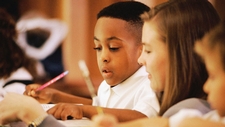Communicating Conclusions

TEKS Objective
The student is expected to communicate observations and justify explanations using student-generated data from simple descriptive investigations.
Essential Understanding
The student develops abilities necessary to do scientific inquiry in classroom and outdoor investigations.
Science Background
How to Deliver a Good Oral Presentation: Discovery Education (website) - Many students (and adults) find it nerve-wracking, even frightening, to give a public presentation. This article provides guidelines for student science fair presentations, but the broad tips provided can help students (and teachers) to give successful, confident verbal presentations in any setting.
How to Deliver a Good Oral Presentation
Discovery Education, www.discoveryeducation.com
Signature Lesson
Drops on Pennies: PBS Kids (website) - In this simple, descriptive investigation, students predict how many drops of water will fit on a penny and then test their predictions. Students record and communicate their findings, and justify their explations to the class.
- Supporting Lessons
- Extensions
- Assessment Ideas
- Literature Connections
- Related
TEKS - Additional Resources
Supporting Lessons
Delta Wing Flyer: PBS Kids (website) - Students create gliders out of paper and drinking straws, and test the effects of different variables (addition of paper clips on different parts of the plane, use of tissue paper instead of newspaper, etc.) on the distance a glider flies. Students then record and explain their results to the class.
Elaboration Lessons and Extensions
Gravity: Utah Education Network (website) - Students investigate the effect of gravity on various objects, measuring and recording the amount of time it takes different objects to fall the same distance. After they have analyzed their data, students will communicate their conclusions to the class.
Assessment Ideas
Provide students (or student groups) with four similarly sized balls made of different materials, such as clay, paper, rubber, aluminum, etc. Have students design and conduct an investigation to determine which ball will drop the fastest. Then have them communicate their results in writing or verbally.
Literature Connections
So Do You Have a Science Fair Project. Henderson, J. (ISBN-13: 978-0471202561)
Additional Resources
Science Notebooks in K-12 Classrooms: Science Notebooks.org (website) - Science notebooks can improve students’ science understanding, while also enhancing their reading, writing, mathematics and communications skills. This site provides examples of student work from science notebooks and tips for using science notebooks in your class.
TEKS Navigation
Grade 2
Need Assistance?
If you need help or have a question please use the links below to help resolve your problem.

Comments